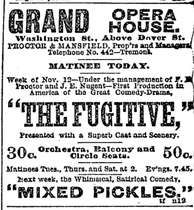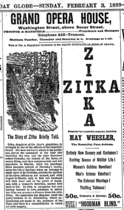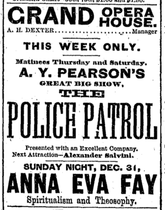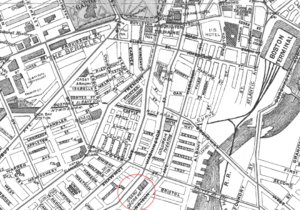Grand Opera House (Boston)
Appearance
The Grand Opera House (est.1888) of Boston, Massachusetts, was a theatre in the South End.[1][2] Architect George Snell designed the 2,600-seat building on Washington Street.[3][4] Managers and proprietors included Proctor & Mansfield,[5] A.H. Dexter,[6] George W. Magee,[7] and Stair & Wilbur.[8] Performances included Glyn's Three Weeks.[9]
References
- ^ Grand Opera House, no.1176 Washington St. Boston Almanac, 1889, 1891, 1893-1894; Boston Register and Business Directory, 1921
- ^ Desirée J. Garcia (2007). "Subversive Sounds: Ethnic Spectatorship and Boston's Nickelodeon Theatres, 1907-1914". Film History. 19.
- ^ The dramatic year, 1887-88, Boston: Ticknor, 1889
- ^ Julius Cahn's official theatrical guide. NY: 1906
- ^ King's Handbook of Boston, 9th ed. Boston: Moses King, 1889
- ^ Boston Daily Globe, Dec. 29, 1893
- ^ Boston Daily Globe, May 8, 1899; Feb. 5, 1902
- ^ Julius Cahn's official theatrical guide. NY: 1906, 1910
- ^ Neil Miller (2010), Banned in Boston: the Watch and Ward Society's Crusade Against Books, Burlesque, and the Social Evil, Boston: Beacon Press, ISBN 9780807051122 – via Overdrive (subscription required)
Further reading
- Douglass Shand-Tucci (2010). "Dover Street Rag: The Grand Opera House". Boston, Mass.: Back Bay Historical.
External links
Wikimedia Commons has media related to Grand Opera House (Boston).
- Bostonian Society. Photo of Grand Opera House at 1176 Washington Street, ca. 1890
Images
-
Advertisement for "The Fugitive," 1888
-
Advertisement for "Zitka" with May Wheeler, 1889
-
Interior, ca.1890s
-
Advertisement for A.Y. Pearson's "Police Patrol," 1893
-
Detail of 1898 map of Boston, showing Grand Opera House





